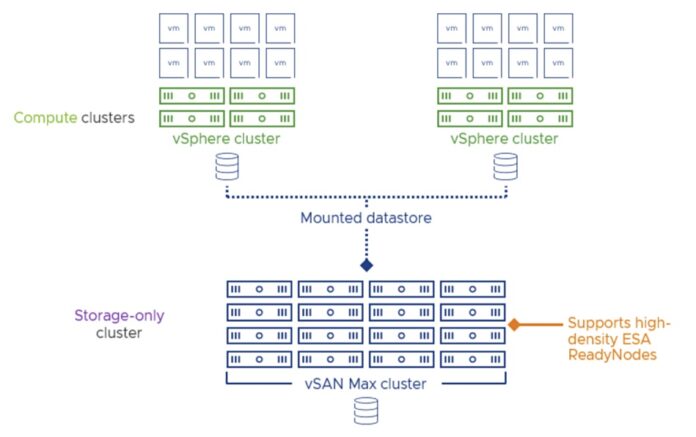VMware has enabled external storage clusters for its vSAN hyperconverged infrastructure (HCI) product, three years after buying Datrium, which focused on the same technology.
The essence of HCI is that compute, storage, and networking are all contained in one chassis with the system scaling up or down by adding or removing hardware. However, that means if you want to additional storage capacity, you have to add more compute as well, and vice versa. Several HCI suppliers partially separated storage from HCI, providing separate resources that could be scaled up and down independently from compute, calling it disaggregated HCI or dHCI.
Nutanix, for instance, provided storage-only Acropolis nodes. HPE-acquired Nimble also has a dHCI product. Datrium was another and NetApp a fourth, with its halted Solidfire-based system.
VMware’s Pete Koehler writes in a blog that vSAN MAX is “VMware’s new disaggregated storage offering that provides Petabyte-scale centralized shared storage for your vSphere clusters.” It’s based on the vSAN Express Storage Architecture introduced in vSAN v8.0. Koehler writes: “Storage resources are disaggregated from compute resources but achieved in such a way that it maintains the capabilities and benefits of HCI while providing the desired flexibility of centralized shared storage.”
The vSAN Max system provides unified block, file, and object storage. It’s scalable with a 24-host vSAN Max cluster delivering up to 8.6PB of capacity and up to 3.4 million IOPS.
VMware says vSAN Express Storage Architecture (ESA), introduced in vSAN v8.0 is an optional, alternative vSAN architecture to the Original Storage Architecture (OSA) that provides different ways to process and store data. ESA provides a log-structured file system, vSAN LFS, that enables vSAN to ingest new data fast, prepare it for a full stripe write, and store metadata in a more efficient and scalable way.
There is a log-structured object manager and data structure, built around a high-performance block engine and key value store that can deliver large write payloads with less metadata overhead. This log-structured design is, VMware says, “highly parallel and helps us drive near device-level performance capabilities in the ESA.”

A vSAN Max cluster can be set up in a single site or stretched across two. It is managed through vCenter Server exactly like traditional vSAN. Koehler suggests a few use cases including a tier one database storage resource, centralized storage for a set of vSphere clusters, and scalable storage for cloud-native apps.
The new vSAN Max offering is expected to be available in the second half of fiscal 2024, and will be licensed separately from existing vSAN editions, offered as a subscription and licensed on a per-tebibyte basis. The license includes everything needed to run a vSAN Max cluster – no licenses of vSphere etc. are needed. Find out more in a vSAN FAQ in VMware’s website.







